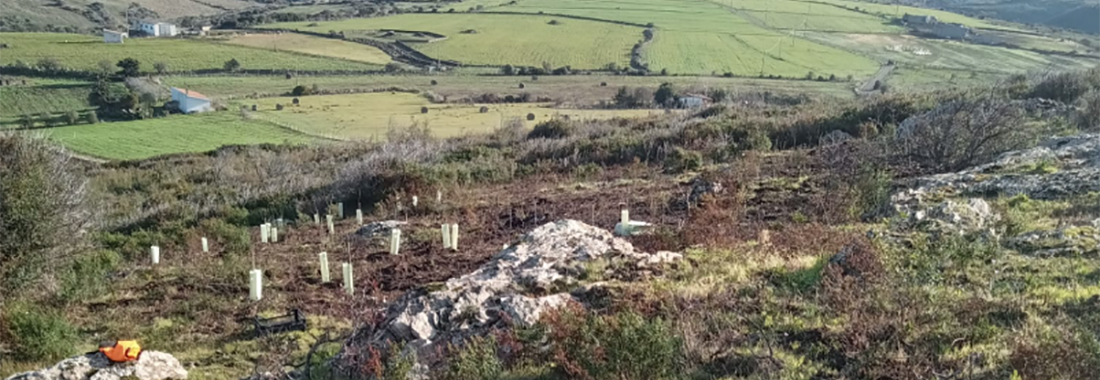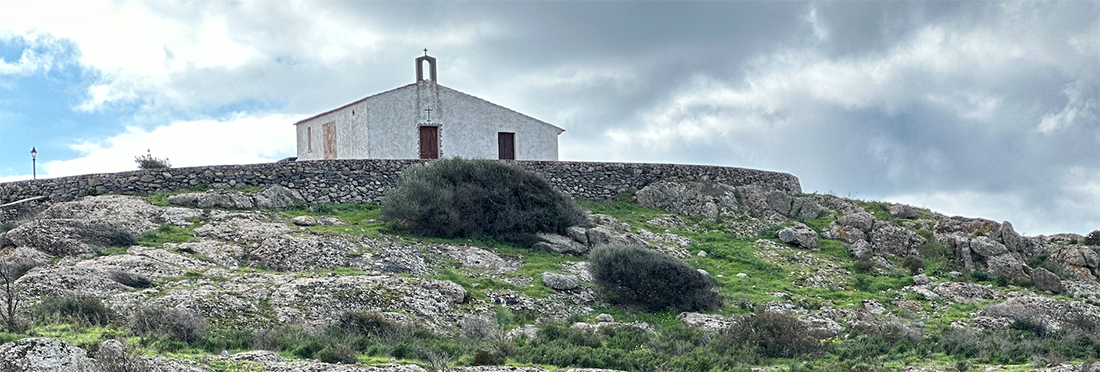Reforestation efforts in Montiferru, led by MEDSEA, are back on track. Following the planting of the first 5 hectares of olive trees, holm oaks, and Mediterranean shrubs, the focus now shifts to melliferous plants to create a "Forest for Bees."
In recent weeks, the MEDSEA team, coordinated by Maria Francesca Nonne, the campaign lead for "A Forest for Bees," has begun preparing the land on the upper northwestern slope of Colle Santa Vittoria in Sennariolo. Around 3,000 seedlings are being planted across 1 hectare, with work set to conclude in the next two months.
The selected plants for the nectar-rich forest, dedicated to bees and natural pollinators, include small species like lavender, rosemary, and helichrysum, as well as medium-sized species such as buckthorn, strawberry tree, blackthorn, and sweet broom. These are interspersed with native plants like rockrose, spike lavender, myrtle, and heather to enhance the site’s biodiversity.
“We carefully chose species best suited to thrive in this wind-exposed area with predominantly rocky soils, featuring pockets of earth between outcrops. These plants are also resilient to the effects of climate change,” explained Nonne. The initiative aims to regenerate the Montiferru area, devastated by a massive fire in July 2021, and to rehabilitate one of its hardest-hit communities, Sennariolo. Beyond restoring the green ecosystem, the project seeks to support biodiversity and the survival of bees and other pollinators, which are severely threatened by climate change.
“One of the most striking consequences of wildfires of this scale, and of fires in general, is the silence that comes from the absence of life," Nonne continued. "To restore balance—particularly for pollinators but also for birdlife—we need plants that disappear after fires, often replaced by aggressive, albeit useful, species like rockrose. This intervention accelerates the process of reestablishing that balance.”
To address recent years' lack of rainfall, five small reservoirs have been installed in the area to provide water for insects during critical periods.
Pollinators, especially bees, play a crucial role in the reproductive and productive cycles of wild and agricultural plants. They transport pollen from the male to the female parts of flowers, enabling reproduction and the production of fruit and seeds essential for humans and animals. Without them, one-third of flowering plants would fail to produce seeds, drastically reducing the availability of fruits and vegetables and causing severe disruptions to supply chains and global food security.
“The ‘A Forest for Bees’ campaign aims to recreate the ideal conditions to support bees and other pollinators, which are fundamental for ecosystem maintenance and food security,” added Piera Pala, president of the MEDSEA Foundation.
The campaign in Sennariolo is supported by local and international companies and initiatives such as Roamers, Patagonia, Extreme E, PlanBee for Despar Sardegna, and CoopAgri Sardegna. Through collaborations with these stakeholders, the campaign not only protects pollinators but also raises awareness about the importance of biodiversity and reforestation in combating climate change. The ultimate goal is to establish a total of 15 hectares of bee forests across Sardinia. "Every contribution, no matter how small, is a step toward a more sustainable future. The call for donors is open," Pala emphasized.
Latest news

A Forest for Bees Takes Root in Sardinia: Restoring Nature, Supporting Pollinators
The planting operations for the first Forest for Bees installation—a forest for bees—have been completed in Sennariolo (OR). This is a special one-hectare forest dedicated to bees and pollinators, essential insects for food…

MEDSEA Launches the Wetland4Change Project in Terralba to test and validate climate change's solutions
On Friday, March 14, 2025, in the council chamber of Terralba, MEDSEA held a meeting with the Municipality of Terralba to officially introduce Wetland4Change to stakeholders (productive activities, as well as institutional…

In Crete with ARTEMIS to protect seagrass meadows: 2nd Consortium Meeting
From March 4th to 6th, 2025, Heraklion (Crete) hosted the mid-term meeting of the ARTEMIS Interreg Euro-MED Natural Heritage project, organized by the Hellenic Marine Research Centre. This was a crucial moment to…

MEDSEA Heads to Tallinn for the Blue4All Consortium Meeting
Last January, the Blue4All project team gathered in Tallinn for the Consortium Meeting, marking the project's halfway point. The event, hosted by the local partner Keskkonnaamet/Estonian Environmental Board and the University of Tartu, brought together all 22 project partners from across…

ImPelaghiamoci: A Year of Initiatives to Learn About and Protect Cetaceans with the Municipality of Sassari
Promoting greater knowledge of the resident cetaceans in the Pelagos Sanctuary*, a transboundary marine protected area encompassing France, Liguria, Tuscany, and Sardinia, to improve the protection and conservation of these species…

Reforestation Operations Resume in Montiferru: A Forest for Bees by MEDSEA
Reforestation efforts in Montiferru, led by MEDSEA, are back on track. Following the planting of the first 5 hectares of olive trees, holm oaks, and Mediterranean shrubs, the focus now shifts to melliferous plants to…

25 Events in Sardinia for World Wetlands Day
Wetlands such as ponds, lagoons, lakes, rivers, and peatlands form an endless world of aquatic ecosystems. In Sardinia, the call to explore these habitats is open this February with the Sardinian edition of World Wetlands Day.

COASTRUST: Launching Sustainable Coastal Management in Domus de Maria Sardinia
The activities of the COASTRUST project, funded by the European Interreg Euro-MED program, have officially begun in Sardinia. The initiative aims to promote shared environmental management in the Mediterranean's coastal areas, addressing anthropogenic pressures…

Join the World Wetlands Day Sardinia 2025 Calendar: register your Event by January, 22nd
World Wetlands Day is celebrated every year on February 2, marking the adoption of the Convention on Wetlands signed on February 2, 1971, in Ramsar, on the shores of the…

MEDSEA joins the Camargue Red Alert with the Mediterranean Alliance for Wetlands to save birdlife
The MEDSEA Foundation has officially joined 73 other international organizations in signing the Camargue Red Alert, a collective call to action to safeguard the Camargue wetlands in France.

Wetland4Change: MEDSEA in Valencia to Explore Natural Climate Solutions Through Wetlands
The MEDSEA team participated in the second Consortium meeting of the Wetland4Change project in Valencia from November 26 to 28, 2024. The meeting was organized by local project partners, the…

Malta’s First Posidonia Meadow Restoration Project Led by MEDSEA Foundation
Different islands, but similar issues for marine ecosystems, which are heavily threatened by unregulated anchoring from recreational boating and illegal trawling. In Malta, as in Sardinia, the damage is particularly…

We are all at 'Valencia'-like risk, and here’s why
Le recenti inondazioni a Valencia sono un esempio tangibile di come gli eventi estremi legati al cambiamento climatico stiano aumentando in frequenza, intensità e durata, colpendo duramente il Mediterraneo, un vero e proprio…

Monitoring of Posidonia oceanica Meadows Begins in the Marine Protected Area of Capo Testa Punta Falcone
The monitoring activities of the Posidonia oceanica meadows in the Marine Protected Area (MPA) of Capo Testa Punta Falcone, located in Santa Teresa Gallura, have officially begun. In recent days, the marine…

MEDSEA joined the 7th TransformAr Consortium Meeting in Exeter
In Late September, the seventh Consortium Meeting of TransformAr took place in Exeter in South West England, organised by the partner Westcountry Rivers Trust, who are coordinating the Nature Based solutions in the…

Architecture and Environment of Wetlands at Costa Produttiva, September 8-14 in Marceddì
From September 8 to 14, Marceddì (OR) hosted Costa Produttiva, a multidisciplinary workshop that combines research, innovation, and sustainability for the future of our coasts. Organized by the DICAAR of the…
- 1
- 2
- 3
- 4


